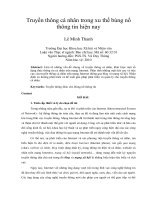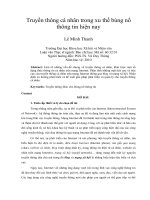Xu thế thiết kế mã Độc hiện nay
Bạn đang xem bản rút gọn của tài liệu. Xem và tải ngay bản đầy đủ của tài liệu tại đây (353.92 KB, 12 trang )
<span class="text_page_counter">Trang 1</span><div class="page_container" data-page="1">
Vlad Constantin Craciun<small>1</small>, Andrei Mogage<small>2</small>, and Emil Simion<small>3</small>
University Politehnica of Bucharest,
Keywords: cyber threat · ransomware · cryptography · cyber security
The ransomware nightmare is taking over the internet impacting common users,small businesses and large ones. The interest and investment which are pushedinto this market each month, tells us a few things about the evolution of bothtechnical and social engineering and what to expect in the short-coming futurefrom them. In this paper we analyze how ransomware programs developed in thelast few years and how they were released in certain market segments throughoutthe deep web via RaaS, exploits or SPAM, while learning from their own mistakesto bring profit to the next level. We will also try to highlight some mistakesthat were made, which allowed recovering the encrypted data, along with theransomware authors preference for specific encryption types, how they got todistribute, the silent agreement between ransomwares, coin-miners and bot-netsand some edge cases of encryption, which may prove to be exploitable in theshort-coming future.
From what we know, the first ransomware, ”AIDS Trojan”[1], was a basic, yeteffective at the time, malware used for extortion attacks. Shortly after, a betterversion of the extortion malware appeared, as suggested in [2], which used publickey cryptography instead of symmetric one. The ransomware phenomenon hasseen an alarmingly increase in the last couple of years, along with its methods ofdistribution and infection. However, no matter how exotic such an applicationmight look, they all reduce to some common features: spreading, encryption, keysharing and key building. Based on the large number of ransomware samplescollected and analyzed in the past few years at Bitdefender Labs, we can bringto surface some of these features and where possible, additional environmentalspecs. They change as they evolve in a continuously updating chain, to maximizethe creators profit and minimize the effort pushed into this business. We canactually see how these threats get more and more complex, through a silent
</div><span class="text_page_counter">Trang 2</span><div class="page_container" data-page="2">agreement with malicious services provides on black market (Ex: packers, net delivery, spam delivery, etc.). Starting with the fall of 2016 we assist to somevisible changes and agreements which take place:
bot-• Troldesh / Crysis and another few ransomwares are now only distributedmanually by hackers after they brute-force accounts of company users• A trend in automating the monetizing system is to have a Ransomware As a
Service for your ransomware, so common people will enroll to make moneywith a given ransomware
• More ransomwares make use of a well known bot-net (Emotet) packer tobetter protect their payload. This packer is known for its polymorphic cloudinfrastructure
• Recent bot-nets just became a service providers for other threat creatorsand some of them like CoreBot is able to tell ransomware owners if thesystems they were deployed on, belongs to companies or not in order todeploy the ransomware where their authors are guaranteed a high percentfor the ransom payment
• By the fall of 2017 we have seen a mix between crypto currency minersand ransomwares and UIWIX is such a ransomware which at that time wasdeployed in certain conditions by Adylkuzz coinminer which among otherslike it, used the EternalBlue SMB exploit to spread in local area networks
Various means of distribution of infection have been seen throughout the tire ransomware phenomenon. One of the easiest and most common way is viaspam. This includes emails, which contain malicious scripts, or documents, whichdownload and run the malicious samples. Another way is to create fake websites(usually which include other phishing techniques) which will trick the user intodownloading and running the file. Both of these can be combined with the filelessmalware attack, where a malware sample would be loaded directly into memory,leaving no physical trace (i.e. on the disk).
en-Another frequent method is to exploit various security flaws found at ware, operating system or hardware levels. A famous example is WannaCry ran-somware, which would be distributed via EternalBlue exploit. This was basedon a vulnerability at the Samba protocol, which allowed an attacker to injectmalicious code remotely. Another example is the second version of SynAck ran-somware, which uses Process Doppelgăanging technique.This involves replacingthe memory of a legitimate process through exploiting some Windows built-infunctions (NTFS transactions – in this case) and how the Windows loader works.Both of them are based on fileless malware attacks.
soft-A method of distribution which occurred especially among the Troldesh somware family (which includes Troldesh, XTBL, Dharma, Crysis) is brute-forcing the credentials through Remote Desktop Protocol. Once the attackerobtained access, it would manually disable any security product and then man-ually run the malicious samples. This also occurs in various cases of botnets
</div><span class="text_page_counter">Trang 3</span><div class="page_container" data-page="3">ran-and/or coin-miners. What is interesting is that only on various occasions any ofthese techniques are part of an Advanced Persistent Threat, meaning that theattackers are interested in making as many victims as possible, without restrict-ing their attack to a specific zone or victim. A few exception have been seen onsome ransomwares which will not infect victims based on geographic location(i.e. GandCrab excepts Russia IPs).
As concluded from our research, most of the ransomwares are using standardalgorithms both for encryption (Ex: AES, RSA, Blowfish, RC4) and hashing (SHA256, MD5). What is interesting is that there is a high percent (above 80%)of those who prefer standard libraries, such as OS API or OpenSSL and only afew choosing to have proprietary implementations like Salsa, ChaCha, or slightlychanged common algorithms like AES512.
We identify about 4 different key management types among all ransomwarefamilies:
• Downloading a secret key/key-stream, to globally encrypt all user files• Creating a random key to encrypt all user files and uploading it to a server• Using a constant shipped key easy to recover by reverse-engineering the
binary sample, or easy to break encryption algorithms
• Using a shipped RSA public key to encrypt random generated AES keysused for file-encryption
• Using ECDH method (only a few cases)
There is a small number of ransomwares which prefers to upload or downloadtheir keys, because it is difficult for the author to ensure that the server will beonline at the time of encryption. The bad guys will not risk to get discoveredby the authorities by leaving public-available servers which could be sized forinvestigations. They also cannot risk to encrypt user files without making surethat they can correlate a key with an affected user. However, we have a few suchcases described in Table-1 and one of them will be further described in Cornercases section.
Ransomware name Key exchange Encryption
ACCDFISA Upload Password Protected Rar SFX archives
LockCrypt Download Custom block-cypherTable-1 : [Threat-Owner] Key sharing mechanism
There is a higher preference for local key generation instead of using a keyobtained by other means, which we will discuss soon, due to its increased secu-rity and transparency for ransomware creators. Many of the ransomwares wholocally generate the encryption key are either using some secure key generatoralgorithms available in OS API or OpenSSL, deriving a SECP elliptic curvemaster key, or using an insecure key generator, which can lead to a breakablekey as seen in Table-2.
</div><span class="text_page_counter">Trang 4</span><div class="page_container" data-page="4">Ransomware name Encryption Key
Nemesis AES256/512, ECB,CBC Time (C rand() function)
Table-2 : Ransomwares using weak key generator or weak encryptionThe ransomware families using proprietary encryption algorithms usuallyprefer easy to revert light XOR operations or RC4 encryption with low-securitykey generators or even worse, with plain-text keys. Table-2, Fig. 1 and Fig. 2reveals something about the encryption mechanisms available in Nemucod andOpenToYou ransomwares. The recovery of files affected by these ransomwaresis possible not because of the weak-keys involved, but because the encryptionalgorithms are breakable. For OpenToYou ransomware, it is sufficient to have apair of encrypted and not encrypted files to recover all the affected files, becausewe know that RC4 function actually applies a xor operation between a key-stream and the actual data allowing the recovery of the key-stream from a pairof {encrypted, original} pieces of data.
We already know that for RC4 encryption, the following affirmations willlead us to decrypt any file starting from a pair of encrypted and not encryptedfiles, because the Key Stream can be computed using two different methods:
RC4 = {P, KS, KSA, I, O}P − passwordKS−Key Stream
KSA−Key Stream Generator AlgorithmI−Input data
O−Output data
Given the above description and knowing that KS = KSA(P ), we can encryptI with KS, obtaining O = KS ⊕ I. However having I and O can lead us to avalid KS, without knowing P , because KS = O ⊕ I
The most of the ransomware families nowadays will choose for RSA / ECDHkey exchange mechanisms because they are more secure. They also ease the entirekey-management, leaving the hacker with a map of user IDs and RSA keys usedfor encryption. The ransomware authors only require for the affected users ID,to get their correct decryption keys. There are a lot of sub-cases of using thistype of keys, but all of them fall back to the same mechanism of having RSAto encrypt some symmetric encryption keys and not the actual user data. Mostof the RSA keys range from 1024 to 4096 bits and there are a few mistakes of
</div><span class="text_page_counter">Trang 5</span><div class="page_container" data-page="5">Fig. 1 - Nemucod rolling key
Fig. 2 - Block of zero encrypted bytes with RC4 (OpenToYou)
keys less than 1024 bit which have been broken. As far we have seen about threeslightly different RSA layering, considered by ransomwares:
1. shipped RSA public key to encrypt a global AES key. AES key is used toencrypt the user data
2. shipped RSA public key to encrypt random AES keys, AES key is generatedfor each file to be encrypted
3. shipped RSA public key A to encrypt another random generated RSA privatekey B. The RSA public key B is used to encrypt random AES keys for eachfile. The encrypted RSA private key B is stored on user system ready toupload and decrypt on ransomware-owner servers
The third RSA layering is actually used by the WannaCry ransomware andsome of its successors. The ransomware owners secure that way their privatekeys and do not expose them to users which pay the ransom. Obtaining the Aprivate key is not possible. This is a multi layer RSA introduced to deal withcases where an affected user paying the ransom could share the received privatekeys with other users affected by the same binary. Troldesh/Crysis ransomwarecreators, for instance will provide a binary file containing a RSA private keyafter paying the ransom, which will actually decrypt about 15 different sub-versions. Those who run these businesses are aware of the fact that multipleusers can get affected by the same ransomware binary, so they need a way tokeep secret their keys when users pay the ransom and the same tine to minimizethe hacker-user interaction or their servers availability. Table-3 reveals a coupleof ransomwares using the RSA key encryption with their preference for one ofthe above 3 mentioned RSA layering.
</div><span class="text_page_counter">Trang 6</span><div class="page_container" data-page="6">Ransomware name RSA Key countTroldesh / Crysis 1
GlobeImposter 2
Table-3 : RSA key count / threat
There are a few ransomware families which use ECDH for key exchange.We tend to consider any ransomware using RSA or ECDH to be unbreakable,however about 2 years ago in May 2016, a researcher found that TeslaCryptransomware (first two versions) which used ECDH, was breakable because ofthe key encoding mechanism. We believe that authors wanted to store 1024 bitpublic keys inside the encrypted files, but they actually stored the 1024 bit keyas ASCII hex, reducing the keys to 512 bit. Some of these keys are breakable inabout seconds using factoring tools like Yafu and Msieve. The authors updatedthis weakness in their 3rd and 4th ransomware version. While Fig. 3 reveals anactual 512 bit hex-ASCII key stored in an encrypted file, Fig. 4 is a snapshottaken from an actual factorization of that key.
Fig. 3 - 512 bit public ECDH session key - TeslaCrypt
Fig. 4 - Factoring the above key with Yafu on a i7 CPU, 8 threads
</div><span class="text_page_counter">Trang 7</span><div class="page_container" data-page="7">5The environmental advantage
To ensure that file recovery is not possible and the ransomware will execute inmost operating system environments, ransomware owners must be aware of theenvironment where encryption will take place, how it looks like and how canbe tuned to help them with the encryption. On Windows operating systems, aransomware will not start the encryption process until the vssadmin service isnot disabled as a preceding step. This service is used for shadow volume copiessuch that lost data can be recovered if the disk has enough free space. Otherransomwares like GobeImposter which are more recently spread through RDPbrute-forced accounts are created to auto-cleanup the author intervention andremoves some event-logs and RDP logs after the execution ends. The environ-ment is most of the time vulnerable to certain behaviors, be it an applicationvulnerability (MS Office Word memory corruption CVE-2018-0802), an admin-istrative weakness (unauthorized installation of WMI scripts/services, unautho-rized uninstall of security products) or an operating system kernel vulnerabilitylike MS17-010 first exploited by WannaCry back in 2017. Below there are a fewspecial cases of ransomwares taking advantage of the environment and/or otheropen-source tools.
• AVCrypt make use of WMI commands to uninstall Emsisoft security uct:
prod-cmd.exe /C wmic product where ( Vendor like ”%Emsisoft%” )call uninstall /nointeractive & shutdown /a
• SamSam/Samas ransomware uses Active Directory on Windows servers toquery users and then uses them to spread over the Local Area Network. Theransomware is also able to exploit a vulnerability in Boss JMX-Console tobypass authentication.
• NotPetya / Petwrap / BadRabbit make use of Mimikats tools to grab usercredentials from operating system internal tables and use them to spread thethreat over the network.
One major observation found among the entire ransomware phenomenon is thatthe authors or attackers rarely have good or even decent cryptography knowl-edge. Various indicators were found to support this claim:
• Ransomwares such as Xmas, Xorist, Bart, Globe generate an encryptionkey for AES using the random() function from C. This leads to an easyrecoverable key, by having a generation space of 232 bits, which can bebrute-forced in a reasonable time.
• Encryption using CBC mode having the Initialization Vector equal to 0.While this does not always support the key recovery, it makes the encryptionprocess less secure and, in combination with the previous point, makes therecovery process even faster.
</div><span class="text_page_counter">Trang 8</span><div class="page_container" data-page="8">• Flawed implementation: some authors try manually to implement an tion scheme and do not take all security measures, resulting in a possibleexploitable scheme. Such a case can be seen in some versions of Nemesisransomware, where the author tried to implement a version of AES basedon 512 bits length of both encrypted block and key. A similar case is thefirst version of Petya (Red Petya) which implemented a custom Salsa20, ex-plained in [4] which use 32 bit words in the proposed design, but only 16bit words in Red Petya implementation, because the boot-loader, encryptingdisk sectors, worked in 16 bit mode. The authors patched this issue in GreenPetya and more recent versions like BadRabbit which use 32 bit boot-loadercode.
encryp-• Using a static key and a basic encryption scheme with no or little graphic properties. Such an example can be found in PCLock, Nemucod,OpenToYou, where a static key was used in a basic XOR scheme.
crypto-• Using simple, exploitable verifications: Cryp0l0cker, for instance, used tomake a request on blockchain.info using a hardcoded BTC address in orderto check whether the victim has paid. Once it received the confirmation,it started to decrypt the files. Therefore, manually modifying the addressto one which already has the minimum of request bitcoins, will trick theransomware into decrypting the files.
• Exploitable services: once the ransom payment has been completed, someransomwares would query a service where they would send the user key anddownload the decryption. Therefore, anyone who knew a victim’s key couldmake the request and obtain the decryption key.
• Damaging the files: cases have been seen where the ransomware would faultyencrypt or write the encrypted data and, therefore, make the data irrecover-able. GandCrab, for instance, would use the SetFilePointer in order to movethe file pointer to overwrite the clear data with the encrypted one. However,the lpDistanceToMoveHigh parameter, which specifies “A pointer to thehigh order 32-bits of the signed 64-bit distance to move” wasn’tused, which leads to the function to fail if the purpose is to move the pointermore than 2 GB. Therefore, the file pointer would not be properly movedand data would be lost.
• Memory persistence : Some ransomwares generate a local key which willbe used to encrypt the entire system and will be kept in memory for theentire process. However, some of them will not exit once all system’s filesare encrypted (so the key will be deleted) and will continue to scan for newfiles. Therefore, anyone with system access can dump the entire memory ofthe process and obtain the key from there.
We believe that the ransomware encryption touches a few corner-cases whichcan be exploited both by the up-coming technologies and math development thesame time. We will refer to 2 special cases of encryption, based on RSA1024
</div><span class="text_page_counter">Trang 9</span><div class="page_container" data-page="9">keys which might be breakable in the near future and some custom encryptionmechanisms which could be braked using tools like Z3 Theorem Prover / Solver.
1. RSA1024
RSA1024 keys can already be broken using special hardware like SHARKexplained in [3]. The problem is that the implementation requires a lot in-vestment (20-30 M$) and the time is not too short with all this.
We also presume that quantum computing along with mathematical vancements will make these keys easy to break in the near future.
ad-2. Custom encryption using Theorem Prover / Solver
A couple of threats (LockCrypt ransomware , ShadowPad botnet) are usingblock-chain encryption based on 64 bit keys or pairs of 32 bit keys. Ourresearch using Z3 Solver from Microsoft, proves that knowing the first 16-32bytes of the output can lead to a corresponding equation system which mightgive us the decryption key without actually attempting a full brute-force.The below piece of code is an example of encrypting a chunk of data using 2x 32bit keys, in a block-chain meaner:
x340D611E #x 0 0 0 0 0 0 1 0 ) ( b v l s h r #x340D611E #x 0 0 0 0 0 0 1 0 ) ) ) ) #x000000FF ) #x000000E6 ) )
As quantum computing becomes more and more closer to reality, the problemof quantum cryptography arises. Despite the fact that a theoretical theorem has
</div><span class="text_page_counter">Trang 10</span><div class="page_container" data-page="10">proven that a quantum computer cannot perform general arbitrary computation,it can be used to access specific quantum states and perform operations that aresimilar. As theoretically proven, a quantum computer can perform calculationsmuch more quickly than a classical one and, thus, can attack most of currentencryption schemes.
To prevent this, researchers are working on post-quantum or quantum-resistantcryptography[5], which provides encryption schemes, most of them based onpublic-key algorithms, secure against quantum attacks. A way of sharing an en-cryption key through a quantum network is via quantum key distribution[6],which allows sharing a key between two parties without having to rely on athird one. Current popular schemes are not resistant to quantum attacks mainlybecause they rely on difficult mathematical problems, such as discrete loga-rithm, integer factorization, elliptic-curve discrete logarithm, quadratic residu-osity problems.
However, once quantum cryptography will be practically implementable, erything we currently know as security will be shifted. Obviously, the malicioussoftware will be changed as well. Therefore, this bring the possibility of quan-tum malware or, more closer to the subject, quantum ransomware. One can onlyassume what such a concept implies at this point in time. Despite the securitymeasures that will be taken, it is highly possible that the quantum computer willbe somehow exploitable. Therefore, an attacker might build a quantum malwarethat performs similarly to a ransomware, but based on quantum cryptography.What is more, other scenarios imply altering the quantum states, altering asystem through ”illegally” entaglements, perform quantum distributed attacks(similar to DDoS), etc.
BadRabbit, like its predecessor NotPetya/PetWrap make use of disk encryptionand tools like mimikatz to break user credentials and move forward on all possiblecomputers inside a network. It also make use of RDP exploit, but a slightlydifferent version of EternalBlue - EternalRomance. Table-4 reveals a serie ofnetwork shares, users and credentials preloaded with the binary:
</div>








